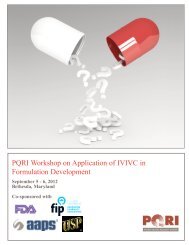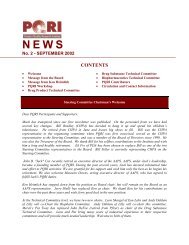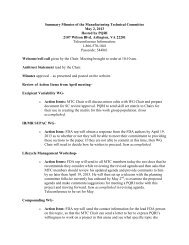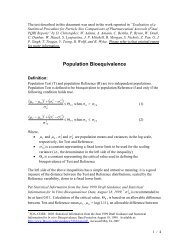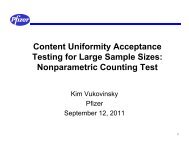Device Design Similarity - PQRI
Device Design Similarity - PQRI
Device Design Similarity - PQRI
You also want an ePaper? Increase the reach of your titles
YUMPU automatically turns print PDFs into web optimized ePapers that Google loves.
Workshop QuestionsQ1: What is necessary to demonstrate device sameness in thehands of the patient ?What are the criteria for establishing similarity of operating principleand design for inhaled devices ?Q2 : What is the role of in-vitro testing in determining devicecomparability. What are the opportunities for using methodsbeyond cascade impaction ?When comparing devices what is considered to becomparable aerosol performance ?Q3: What considerations are necessary when demonstrating devicesameness across different patient populations e.g. from adultsto paediatrics, asthmatics to COPD patients ?
<strong>Device</strong> sameness• Questions raised included– How similar do devices need to be ?– Does sameness concept apply to generic andinnovator products alike ?– What if is the test product is an improvement overreference– What if metering principle is different between devices– What are appropriate robustness standards andfailure rates ?– Will the ANDA route ever be feasible for a DPI ?– What changes are allow within the label/Instructionsfor Use for products filed via an ANDA ?• Diversity of different devices leads to the use ofrisk management approaches
<strong>Design</strong> Changes• Intra-<strong>Device</strong> and Inter-<strong>Device</strong> changes– <strong>Device</strong> and formulation switch (genericintroduction)– <strong>Device</strong> switch (evolving the productlifecycle)– <strong>Device</strong> modification (lifecyclemanagement)• Sameness and <strong>Similarity</strong>– Can or should these terms be usedinterchangeably ?
<strong>Device</strong> <strong>Similarity</strong>Concept applies to innovator and generic devices alikeIncreasing <strong>Device</strong> <strong>Similarity</strong>Differencesin devicedesignNoncriticalchange indeviceCosmeticchangeChange inplasticSupply chain• Application of risk assessment based on product knowledge and scientificunderstanding and Target Product Profile• Judging risk is challenging – severe, medium, low ?
<strong>Design</strong> <strong>Similarity</strong> Risk Assessment• Defining a design change- “what matters to a patient ?” => Target ProductProfile– Is the change visible to the patient ?• Different device type – MDI to DPI, Reservoir to Pre-metered (diiferentshap• (e.g. adding dose counter)• Reduction in number of parts– Does the change influence the way the patient interfaces with the deviceduring the inhalation manoeuvre ?• E.g. change in mouthpiece geometry• Can a patient tell a difference between changes in Q2 formulation ?– Does the change potentially impact product performance (safety/efficacy) ?• Change in formulation• <strong>Device</strong> material change resulting in changed electrostatic properties– Does the change potentially impact patient safety ?• Material change (biocompatibility/extractables leachables)• Would more information in the public domain assist in consistent assessment of riskseverity ?
How do you assess device similarity ?• In-vitro design space– Discussion on relevance of impaction testing– Need for range of flow rates for DPI – alsoconsider flow volume– Opportunities for improvement• Patient relevant flow profiles– Challenges in sampling / use of isokinetic sampling ?– Other tests eg actuation force
How do you assess device similarity ?• Human Factors– Need to consider the impact on the patient interface.– No ‘Gold standard test’, depends on nature of thedifference and product.– => Is there need for a guiding principles on this toaddress the most important point ofinterchangeability?– => What is the correct patient group selection ?– Driven By Risk Assessment• Cosmetic change / battery change – handling study ??• Difference potentially impacts inhalation manoeuvre – moreextensive evaluation– Differences in instructions / Training
How do you assess device similarity ?• Robustness testing ? What is robustness ?– If you want to achieve equivalent robustness betweenA and B then appropriate standards are required(common standard).– If there is a difference what is the relevance ?– What is the acceptable level of complaints/devicefailures in assessment of similarity ?• 1 in 10,000, 1 in 100,000, 1 in 1,000,000 ?• Patient misuse– Do differences impact potential patient misusescenarios ?
Conclusions and Next Steps• Establish feasibility of cross-industrysurvey of classification of change risk andproposed technical evaluations– Potential changes– Classifications of risk– Definition of appropriate evaluation studies




